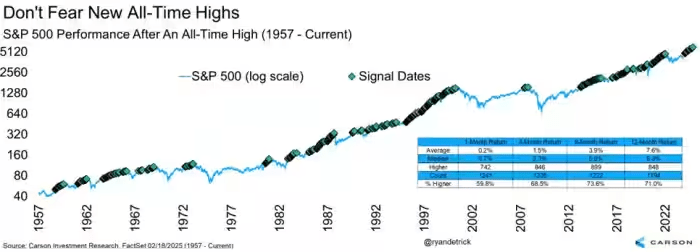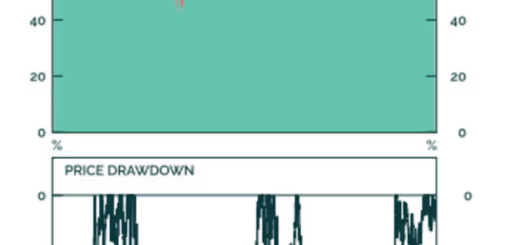New Highs for U.S. Stocks—Boom or Bubble?
Investors Should Embrace Stocks Record Highs While Staying Vigilant
For the first time in nearly four weeks, the S&P 500 reached a new closing high on Tuesday. Investors who have remained on the sidelines may now be wondering: Is it too late to enter the market?
After two years of strong gains, it’s natural to question whether to invest now or wait for a potential pullback. As the saying goes, “trees don’t grow to the sky”—markets don’t rise indefinitely without pauses or corrections.
New market highs can shape investor sentiment, but history shows they are not unusual. Ryan Detrick, chief market strategist at Carson Group, notes that since 1957, the S&P 500 has reached a new record high roughly every three weeks on average.
This doesn’t mean stocks are immune to downturns. While bear markets occur, they have historically been infrequent. Investors who remain on the sidelines often miss out on significant long-term gains.
“Should you buy at all-time highs? That’s a frequent question,” Detrick shared on X. “My take: Don’t fear new highs. The S&P 500 has risen a year later 71% of the time after reaching a record, with a median return of 8.3%—essentially normal returns.”

Of course, exceptions exist. The S&P 500 hit a record of 4,796.56 on January 3, 2022, before declining 25% in a bear market. It took over two years to surpass that peak.
However, such downturns are the exception, not the rule. Historically, stocks trend upward over time, particularly following the recovery from the 2008 financial crisis.
Key Risks to Consider
Despite market resilience, investors should remain mindful of emerging risks. Several challenges have surfaced at a time when U.S. large-cap valuations are historically high. Additionally, seasonal trends indicate that the first quarter of a new presidential term is often one of the weakest in the four-year cycle, according to Detrick.
Potential concerns include:
- AI Competition: China’s DeepSeek AI program challenges U.S. dominance in artificial intelligence, a key tech-sector driver.
- Trade Policy Uncertainty: President Donald Trump’s shifting trade policies introduce market volatility.
- Labor Market Concerns: Government job cuts raise questions about employment stability.
- Federal Reserve Policy: The Fed has paused its planned interest-rate cuts, leaving investors uncertain about future monetary policy.
- Historical Patterns: Some investors take note of an unusual pattern—Philadelphia sports victories, such as the Eagles’ recent Super Bowl win, have sometimes coincided with economic turbulence.
Thus far, investors have largely brushed off these risks, but sentiment can shift quickly.
Market Breadth and Leadership
While the “Magnificent Seven” megacap tech stocks have struggled in early 2025, other stocks have gained ground, broadening the market rally. This diversification reduces the market’s vulnerability to single-stock declines, such as Nvidia Corp.’s sharp 17% drop in late January, which caused the S&P 500 to fall nearly 1.5%, despite gains in most other index components.
The S&P 500’s rise has slowed in 2025, but broader participation suggests a more stable rally. Year to date, the index is up 4.2% as of midday Wednesday. The Invesco S&P 500 Equal Weight ETF (RSP), which better reflects the performance of the average S&P 500 stock, has gained 4%, according to FactSet.
Looking Back and Moving Forward
Exactly five years ago, on February 19, 2020, the S&P 500 hit a record before the COVID-19 pandemic disrupted global markets. Since then, the index has climbed more than 80%, according to FactSet data. By late summer 2020, it had fully recovered from the pandemic-induced selloff.
As of Wednesday’s trading session, the S&P 500 was down 6 points, or 0.1%, at 6,122. The Nasdaq Composite declined 53 points, or 0.3%, to 19,990, while the Dow Jones Industrial Average dropped 144 points, or 0.3%, to 44,413.
While new highs may seem concerning, history suggests they are a natural part of market cycles. Investors who take a measured approach and maintain a long-term perspective are often rewarded over time.




